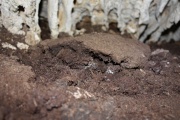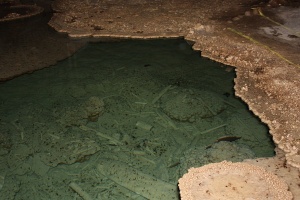Vertebrate (Inventory)/Bat Guano
From LagWiki
(Difference between revisions)
| Line 7: | Line 7: | ||
If a significant accumulation is found, examine the ceiling above for bats and [[Vertebrate (Inventory)/other#Bat stains|bat stains]]. Historic piles of guano often contain [[Vertebrate (Inventory)/Bat Bones|bat bones]]. | If a significant accumulation is found, examine the ceiling above for bats and [[Vertebrate (Inventory)/other#Bat stains|bat stains]]. Historic piles of guano often contain [[Vertebrate (Inventory)/Bat Bones|bat bones]]. | ||
| + | |||
| + | <gallery caption=Gallery perrow=1 widths=300px heights=200px> | ||
| + | File:Guano pool.JPG|Bat guano in and around a pool | ||
| + | </gallery> | ||
==See also== | ==See also== | ||
Revision as of 01:26, 1 November 2011
The Bat Guano field should be used to record any stations which exhibit bat guano.
Bat guano is the excrement left behind by bats. It can be found on the cave floor, on formations, or in pools. It can be a sprinkling of small, dark pellets or, with the passage of time, be piles that are many feet deep. Guano may be old and historic or fresh and young. It could be dry and powdery or wet. Any recognized bat guano should be recorded.
It can be under, over or layered with flowstone and other secondary deposits.
If a significant accumulation is found, examine the ceiling above for bats and bat stains. Historic piles of guano often contain bat bones.
See also
References
- unknown (1997) Geology of Carlsbad Caverns Class - 1997 Memorial Day Expedition p 2


